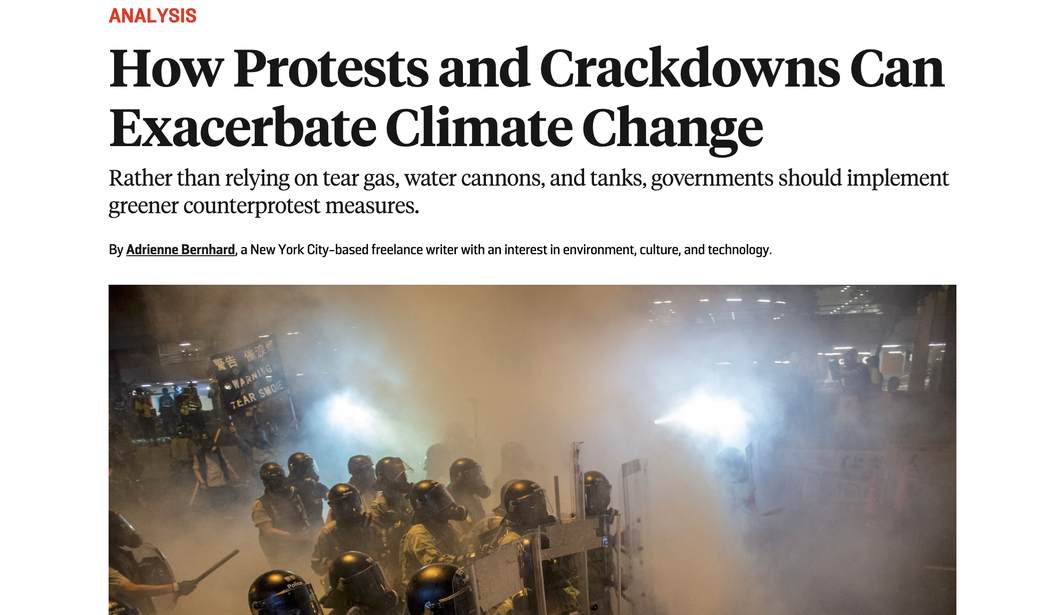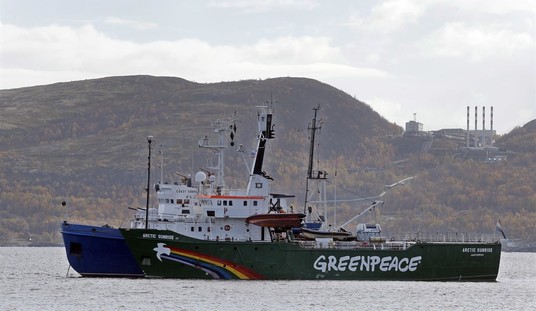The murder of Mahsa Amini by Iran’s “morality police” sparked months of protests in the country. Iranians are standing up to their brutal regime, and the regime is striking back as best it can with all the means at its disposal.
This worries Foreign Policy, the formerly prestigious journal that is widely read in academic and diplomatic circles. As well it should, because nobody has a clear accounting for how those protests and the measures might damage the climate.
The climate. We should worry about the climate. The protesters? Perhaps they should consider the climate impact of fighting back.
Sure, the death of protesters sucks and all, but the climate, man, the climate! Keep your eye on the ball!
Since the death of 22-year-old Mahsa Amini in September at the hands of Iran’s abusive so-called morality police, protests have spread across the country. Iranian security forces have repeatedly fired at demonstrators, wounding and killing civilians who are taking part in an unprecedented show of dissent. As demonstrations intensified, fires blazed at Tehran’s Evin Prison, inside police vehicles in Noshahr and Mashhad, and throughout the country from burning hijabs, smoke billowing into the sky for days.
Demonstrations like those in Iran—and in Hong Kong, Ukraine, Russia, China, the United States, and elsewhere—are vital exercises of free speech, often essential to policy or regime change. But when clashes between civilians and police turn violent, there is an overlooked cost on both sides: the mutual destruction of shared environmental space. Tear gas, water cannons, pepper spray projectile launches, laser dazzlers, traffic barricades, fires, helicopters, and military tanks—hallmarks of modern protest and counterprotest around the world—cause injuries, endanger human life, and can violate human rights. They may also pose risks to the climate.
This is how far our Elite has sunk. I still can’t get over it. The CLIMATE is the subject of this article. Honestly. A woman’s death has sparked a revolution in Iran, and we are supposed to worry about climate change.
Although crowd control is sometimes a legitimate objective, the state—with its greater resources and potentially greater capacity to cause environmental destruction—has a responsibility to mitigate protests’ environmental impact. Green measures may also help ensure that protest intervention strategy is more humane and less expensive. And there are ways in which even protesters themselves could adopt more sustainable methods of demonstration.
Let’s get a pamphlet out to every Iranian and Chinese protester on how best to be green while being oppressed by a tyrannical government. Because we have to keep our priorities straight when it comes to protecting Gaia.
At least we learned in 2020 that mass protests are not superspreader events, at least the ones that have gone through the intersectional oppression checklist for approval by the public health establishment and the World Economic Forum.
Only protests against COVID restrictions spread COVID. The virus avoids approved protesters, so we only have to worry about protecting Mother Earth. I wonder if the Iranian protesters filled out the right paperwork for that.
There is little available data on the environmental consequences of counterprotest (or protest, for that matter). While the U.S. military and various nonprofits monitor the effects of tear gas on humans, for example, no organization tracks the compound’s effects on plant or animal life.
In Santiago, Chile, tear gas was repeatedly fired alongside the medians that separate city streets during protests in 2017, littering patches of green grass with chemical residue, and there were frequent reports of dead birds turning up on the Chinese University of Hong Kong’s campus during protests in the territory in 2019. (Tear gas had indeed been used.) Storage of outdated tear gas and old munitions dumps can also contaminate groundwater, and the long half-life of these chemicals makes them difficult to eradicate.
“We need more environmental transparency about the use of tear gas,” said Sahan Savas Karatasli, a researcher at the University of North Carolina at Greensboro.
It’s not just tear gas we have to worry about. I suspect that any competent expert on the subject already knows all this stuff. The ignorance on this matter is almost certainly limited to idiots who write for Foreign Policy, not the manufacturers and users of the stuff.
It turns out that everything we do to suppress riots (or to riot) is suspect.
Even when police do not use tear gas, they may rely on other intervention methods that can negatively impact the environment. When demonstrations form, law enforcement authorities often barricade major arteries and roadways to control crowds, forcing vehicles into bottleneck traffic jams that increase emissions. They may launch helicopters in hover patterns or stage armored military tanks or vehicles, which each consume more than half a gallon of fuel an hour when idle.
Modern water cannons, also used to disperse crowds, have flow rates of up to 20 liters (about 5 gallons) per second, expending significant volumes of water and washing the colored dyes and UV chemical markers they frequently deploy over 200 feet away. (Colored dye enables police to “tag” protesters and identify them later.) Agents such as chlorobenzylidene malononitrile, or CS, do not decompose easily; one of the most common chemicals used by law enforcement, CS may be mixed into water cannons and cause secondary impacts. Exposed streets and sidewalks are then lined with toxic residue, which is stirred into the air by traffic and pedestrians or carried into sewers by rainfall.
I love that first paragraph. Every time a head of state moves they cause traffic jams. Every meeting at the UN probably causes untold amounts of fuel to be burned waiting for the diplomatic bigwigs to do their business. Perhaps Foreign Policy should demand that every UN meeting is held by Zoom.
Personally I love that idea. It’s not getting rid of the UN good, but a great start. I imagine that John Kerry’s security team causes a lot of CO2 to be emitted when he goes on his jaunts to defend the climate. But we only worry about CO2 in certain circumstances, depending upon the identity of the emitter.
So what should governments do instead of traditional riot dispersal techniques? Look to China, of course! They know how to oppress people well. Maybe their techniques are bit intrusive, but they get the job done most of the time!
When excessive force and prohibition on freedom of assembly are chief concerns—as they should be—ecofriendly protest measures are never going to be a priority. Compared with emissions from the airline and automotive industries or coal-fired power plants, for example, protest-related pollution seems minor. And green policing alternatives, while potentially less harmful to the environment, can have unintended, even dangerous, consequences for humans.
China, for example, has developed face-mapping technology to disperse crowds, a sustainable government counter-response with significant implications for privacy, while government officials in Kazakhstan recently shut down the internet in response to protests over rising energy costs there.
The article itself is a mess. Even if we cared about the environmental impacts of government tools for oppression rather than the oppression itself, no real solutions for the problem are outlined. China’s social credit system works a lot of the time, but as recent protests show it has its limits–even beyond the obvious fact that it is totalitarian and truly evil. The author herself admits that the Chinese solution is problematic, but offers no alternative.
So perhaps totalitarianism is the preferred solution for Mother Earth.
The premise of the article is morally vacuous. Compared to the basic human rights of the people protesting, or for that matter the necessity of dispersing genuine riots when people and property are put at risk, the environmental impacts of what either the rioters/protesters or the government do are utterly irrelevant.
It’s like complaining that the flight attendant didn’t have honey roasted nuts for you to enjoy as the plane plummets to the ground in a fiery ball. Priorities, man, priorities.
That an elite publication would consider such drivel worthy of publishing tells you everything you need to know about how useless the Elites are. They are laser focused on irrelevancies and utterly indifferent to the most important matters, such as the continued oppression of people in Iran or China. I wonder if they have published a piece on how the Ukraine war could be fought in a more environmentally friendly way.
It takes a monstrous moral midget to use the death of a heroic woman in Iran to kick off a discussion of the environment effects of tear gas and water cannons. And the level of moral vacuity displayed by the editors is beyond my ability to properly describe.
These people disgust me.








Join the conversation as a VIP Member